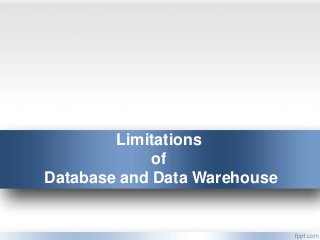Limitations of Database and Data Mining.pptx
•Download as PPTX, PDF•
0 likes•3 views
Data Science
Report
Share
Report
Share

Recommended
Recommended
More than Just Lines on a Map: Best Practices for U.S Bike Routes
This session highlights best practices and lessons learned for U.S. Bike Route System designation, as well as how and why these routes should be integrated into bicycle planning at the local and regional level.
Presenters:
Presenter: Kevin Luecke Toole Design Group
Co-Presenter: Virginia Sullivan Adventure Cycling AssociationMore than Just Lines on a Map: Best Practices for U.S Bike Routes

More than Just Lines on a Map: Best Practices for U.S Bike RoutesProject for Public Spaces & National Center for Biking and Walking
More Related Content
Featured
More than Just Lines on a Map: Best Practices for U.S Bike Routes
This session highlights best practices and lessons learned for U.S. Bike Route System designation, as well as how and why these routes should be integrated into bicycle planning at the local and regional level.
Presenters:
Presenter: Kevin Luecke Toole Design Group
Co-Presenter: Virginia Sullivan Adventure Cycling AssociationMore than Just Lines on a Map: Best Practices for U.S Bike Routes

More than Just Lines on a Map: Best Practices for U.S Bike RoutesProject for Public Spaces & National Center for Biking and Walking
Featured (20)
Content Methodology: A Best Practices Report (Webinar)

Content Methodology: A Best Practices Report (Webinar)
How to Prepare For a Successful Job Search for 2024

How to Prepare For a Successful Job Search for 2024
Social Media Marketing Trends 2024 // The Global Indie Insights

Social Media Marketing Trends 2024 // The Global Indie Insights
Trends In Paid Search: Navigating The Digital Landscape In 2024

Trends In Paid Search: Navigating The Digital Landscape In 2024
5 Public speaking tips from TED - Visualized summary

5 Public speaking tips from TED - Visualized summary
Google's Just Not That Into You: Understanding Core Updates & Search Intent

Google's Just Not That Into You: Understanding Core Updates & Search Intent
The six step guide to practical project management

The six step guide to practical project management
Beginners Guide to TikTok for Search - Rachel Pearson - We are Tilt __ Bright...

Beginners Guide to TikTok for Search - Rachel Pearson - We are Tilt __ Bright...
Unlocking the Power of ChatGPT and AI in Testing - A Real-World Look, present...

Unlocking the Power of ChatGPT and AI in Testing - A Real-World Look, present...
More than Just Lines on a Map: Best Practices for U.S Bike Routes

More than Just Lines on a Map: Best Practices for U.S Bike Routes
Ride the Storm: Navigating Through Unstable Periods / Katerina Rudko (Belka G...

Ride the Storm: Navigating Through Unstable Periods / Katerina Rudko (Belka G...
Good Stuff Happens in 1:1 Meetings: Why you need them and how to do them well

Good Stuff Happens in 1:1 Meetings: Why you need them and how to do them well
Limitations of Database and Data Mining.pptx
- 1. Limitations of Database and Data Warehouse
- 2. Limitations of Databases •Cost of Hardware and Software of an implementing Database system is high which can increase the budget of your organization. •Many DBMS systems are often complex systems, so the training for users to use the DBMS is required. •DBMS can't perform sophisticated calculations •Issues regarding compatibility with systems which is already in place •Data owners may lose control over their data, raising security, ownership, and privacy issues.
- 3. Limitations of Data Warehouses • Adding new data sources takes time, and it is associated with high cost. • Sometimes problems associated with the data warehouse may be undetected for many years. • Data warehouses are high maintenance systems. Extracting, loading, and cleaning data could be time- consuming. • The data warehouse may look simple, but actually, it is too complicated for the average users. You need to provide training to end-users, who end up not using the data mining and warehouse. • Despite best efforts at project management, the scope of data warehousing will always increase.
- 4. What Works Best for You? • Database- To sum up, we can say that the database helps to perform the fundamental operation of business • Data warehouse- To help you to analyze your business. You choose either one of them based on your business goals.
- 5. Basic Key Difference • Database is a collection of related data that represents some elements of the real world whereas Data warehouse is an information system that stores historical and commutative data from single or multiple sources. • Database is designed to record data whereas the Data warehouse is designed to analyze data. • Database is application-oriented-collection of data whereas Data Warehouse is the subject-oriented collection of data. • Database uses Online Transactional Processing (OLTP) whereas Data warehouse uses Online Analytical Processing (OLAP). • Database tables and joins are complicated because they are normalized whereas Data Warehouse tables and joins are easy because they are denormalized. • ER modeling techniques are used for designing Database whereas data modeling techniques are used for designing Data Warehouse.
- 6. Summary • We have seen the limitation of databases and data warehouses